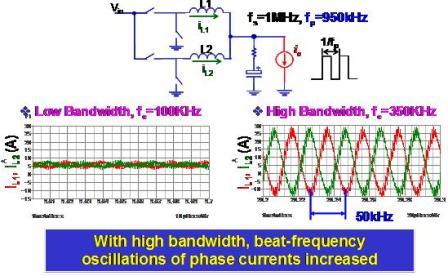There is another merit of the multi-frequency model. The model makes it possible to study the beat-frequency oscillation phenomenon. In some applications such as multiphase voltage regulator for microprocessor, it is possible for the power supply to meet load transients at a repetitive rate even higher than the switching frequency. Depending on the activity of the microprocessor, the frequency of load transients can vary from kHz to MHz range. It has been found that for a multi-phase interleaved VR, when the load transient frequency is close to the switching frequency, huge beat-frequency oscillations can be observed in the inductor currents. Meanwhile, the output voltage waveform does not see beat-frequency oscillation. One example is shown in the test waveforms, where the magnitude of inductor current's oscillation is about ten times higher than it should be. Therefore, it is a severe concern that the beat-frequency oscillations in the inductor currents could result in system failure due to extra stress on the switching devices and magnetics, although they are unobservable at the output terminal.
Conventional averaging modeling technique cannot be used to study this beat-frequency oscillation issue, since there is no information of such frequency component inside the model. The multi-frequency model, on the other hand, includes the beat-frequency components. Therefore, it is convenient to utilize the multi-frequency model to predict the magnitude of beat-frequency oscillations, as well as provide insight for the feedback control design.























































































